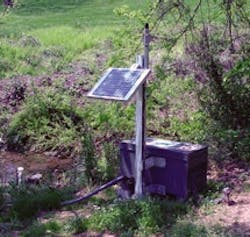Mecklenburg County Finds a Solution to Water Quality Problems
With more than 500 sq miles to cover, including a network of streams flowing through a handful of towns and dozens of active construction sites, the Land Use and Environmental Services Agency in Mecklenburg County, N.C., wanted to get a handle on water quality within its borders. County officials know that booming development sometimes leads to water quality problems downstream from construction, so they wanted to create an early-warning system to notify regulators if a pollution event was in progress.
Officials needed a system that could stream data to their computer network so that their staff wouldn’t need to constantly be in the field checking one of two dozen collection sites. The solution was Mecklenburg’s Continuous Monitoring and Alert Notification Network (CMANN). CMANN is a network of 24 continuously sampling YSI 6820 multiparameter sondes linked by YSI’s EcoNet web-enabled monitoring and control system , which puts real-time water quality information at the fingertips of public works officials and homeowners alike, and notifies regulators immediately of any pollution events.
Mecklenburg County is home to booming Charlotte, N.C. and surrounding cities. Therefore, construction sites are a common feature throughout the area. Similarly to many cities, Charlotte’s sewer system is not fully mapped, which means storm water routes and illicit connections to the system are in many cases overlooked.
The first order of business was gathering baseline data on local water quality. The next task was setting off alarm bells if pollutant levels got out of line. Spikes in turbidity or pH, or plummeting dissolved oxygen levels, could alert officials to out-of-compliance construction sites or illegal hookups to the storm water system. With a population growth of more than 20% between 1990 and 2000, pollution issues have become even more challenging to track.
“Charlotte’s not huge, but when you’re looking to try to pinpoint a problem in a busy area, it can be difficult,” noted Olivia Hutchins, environmental hygienist with the county. “With this system, we can better understand what’s going on in upstream areas, and identify and eliminate sites that could be contributing to the problem.”
Continuous monitoring
Mecklenburg County needed a solution that integrated both water quality monitoring and data management. After looking at the various systems and equipment available, YSI was selected. In April 2005, the county deployed the first 22 of its YSI 6820 multiparameter sondes around the county to inaugurate CMANN. Each sonde measures pH, conductivity, temperature, dissolved oxygen (DO) concentration, and turbidity. An automatic sensor wiping system cleans the turbidity probe regularly, reducing the impact of fouling and increasing the duration of deployment. Continuous monitoring data is supplemented by monitoring for macroinvertebrates and benthic invertebrates, fish, and ambient conditions.
Of the 24 stations slated for the CMANN project, four are used by the county’s Water Quality Erosion Control Program to monitor construction sites for excessive erosion. Three sites are located at critical construction projects to keep a close eye on their impacts on water quality. Four sites will be outfitted as mobile units, with an EcoNet node, datalogger and modem, solar regulator and battery locked in a sturdy box that can be secured to a fencepost and connected to a PVC-jacketed sonde in the river. 13 sites are permanent installations, providing short-term and long-term water quality trends.
- Hutchins, the program manager, can make changes in the site from her desktop or virtually any other computer with internet access;
- Other password-holding internal users can access the site’s “private” level, which allows grouping and analysis of data; and
- A public site (accessed via www.charmeck.org ) allows local landowners and other visitors to view real-time data organized by site and date, even in the user’s own backyard.
Trigger the alarm
Elevated readings trigger alarm messages in the system, alerting Hutchins to a possible pollution problem. To avoid false alarms, such as responding to a “high turbidity” reading that turns out to be caused by a passing fish, CMANN follow-ups are only activated after two consecutive elevated readings.
Hutchins pointed out that seamless integration from data gathering to transmission to web tools – backed up by easy upgrades and attentive tech support – has made the YSI system a great asset for the far-reaching CMANN system.
“I can do some troubleshooting from my desktop, change transmission rates if I want to, watch what’s going on with the equipment, and get an EcoNet node to detect all the equipment connected to it,” said Hutchins.
Data from CMANN has already started to prove its worth. Turbidity spikes have triggered inspections of construction sites and sparked better management of sediment. In addition, installing the first two mobile CMANN units upstream and downstream of suspected trouble sites has had a tremendous impact on regulatory compliance.
“The response we got was unbelievable,” Hutchins recalled. “All of a sudden, the construction companies became very concerned about sediment coming off of their projects.”
Hutchins and her colleagues have also been building invaluable baseline data on local water quality, which will allow the team to better identify problems when they happen.
Steve Werblow is a freelance writer for YSI Inc. Werblow is a graduate of Cornell University's College of Agriculture & Life Sciences and covers environmental and agricultural topics. He can be reached at [email protected].
